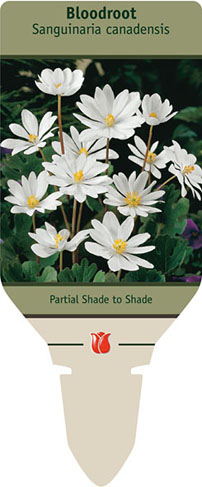Netherland Bulb Company
Known for producing Premium Holland Bulbs 1-800-78-TULIP

Photo © Netherland Bulb Company, Images may not be copied,
altered or reproduced without express written consent.
altered or reproduced without express written consent.
« Previous Plant | Next Plant »
Bloodroot
Sanguinaria canadensis
Native wildflower naturalizes to form colony of deeply-scalloped palmate leaves that produce a white bloom with yellow stamens.
One of our treasured North American woodland wildflowers, the appearance of Bloodroot in the garden is a sure sign of spring. Plants burst out of the ground overnight it seems, with a succession of showy white multi-petalled blooms, leaves appearing as the flowers finish. Foliage is rounded, with deep notches. forming a low clump. Plants often disappear completely by mid summer, particularly in hot regions or if the soil dries out. Choose a site under deciduous trees that is moist during the early spring. Clumps may be divided carefully in midsummer or when dormant later in the autumn. A real gem!
Characteristics:
Bloom Time:
Blooms spring
Mature Height:
6-8 In
Hardiness Zone:
3-8 Find your zone
Exposure:
Partial Sun,Full Shade
Features and Usage:
Greenhouse Growing Instructions:
Grow at 50-65° F providing 50% shade, keeping plants evenly moist but never wet or completely dry. Plants generally finish in 6-10 weeks based on growing conditions.
Plants Per Gallon: 1
Storage Temperature Prior to Planting: 38
Cooler Humidity Prior to Planting: Low
Transplanting Instructions:
Plant in well draining organically rich soil with a neutral to acidic pH. Handle carefully, keep crown of plant just below soil surface and spread roots downward in the pot. Once planted, water immediately to settle the soil around the roots.
Homeowner Planting and Maintenance Tips:
Easy to grow in woodland setting, will form a colony in moist, humus, well-drained soil.
We have done our best to describe this plant as accurately as possible, however, different climates
and growing conditions in different parts of the country will affect height, bloom time, and color.

